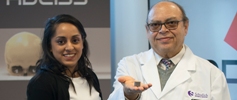Three-dimensional solutions
 Schulich Dentistry researchers are developing novel applications of three-dimensional (3D) printing for use in cranio-facial reconstruction. Amin Rizkalla, PhD, PEng, is the principal investigator and he is working with a team of people, including Yara Hosein, PhD, Drs. Joe Armstrong and Henry Lapointe, as well as David Holdsworth, PhD, to determine how 3D printing can be utilized to develop porous titanium constructs for craniofacial reconstruction. They are hoping that their research will help to solve a large problem in current craniofacial reconstruction methods.
Schulich Dentistry researchers are developing novel applications of three-dimensional (3D) printing for use in cranio-facial reconstruction. Amin Rizkalla, PhD, PEng, is the principal investigator and he is working with a team of people, including Yara Hosein, PhD, Drs. Joe Armstrong and Henry Lapointe, as well as David Holdsworth, PhD, to determine how 3D printing can be utilized to develop porous titanium constructs for craniofacial reconstruction. They are hoping that their research will help to solve a large problem in current craniofacial reconstruction methods.
Because solid metal implants used to repair defects in the skull and face are mechanically stiffer than human bones they create stress shielding, a known adverse reaction. Stress shielding prevents the remodelling process and decreases the amount of loading on the bone, which serves to weaken it. In some cases, when there is an absence of stress on the bone, necessary regeneration does not occur, and the implant will loosen and fail.
“We have looked to 3D metal printing for this project because conventional manufacturing limits the fabrication of complex geometries, such as those expected in our device. 3D printing allows more flexibility in terms of design for customized medical and dental devices,” said Hosein, a postdoctoral fellow in Rizkalla’s lab.
See full article on The Bridge








